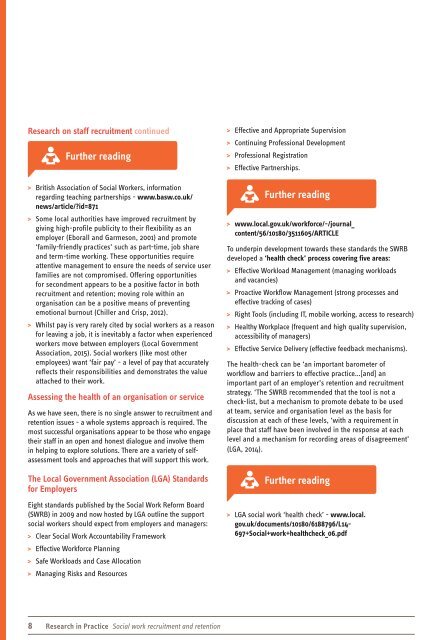Social work recruitment and retention
RiP_Strategic_Briefing_social_work_retention_web
RiP_Strategic_Briefing_social_work_retention_web
You also want an ePaper? Increase the reach of your titles
YUMPU automatically turns print PDFs into web optimized ePapers that Google loves.
Research on staff <strong>recruitment</strong> continued<br />
Further reading<br />
British Association of <strong>Social</strong> Workers, information<br />
regarding teaching partnerships - www.basw.co.uk/<br />
news/article/?id=871<br />
Some local authorities have improved <strong>recruitment</strong> by<br />
giving high-profile publicity to their flexibility as an<br />
employer (Eborall <strong>and</strong> Garmeson, 2001) <strong>and</strong> promote<br />
‘family-friendly practices’ such as part-time, job share<br />
<strong>and</strong> term-time <strong>work</strong>ing. These opportunities require<br />
attentive management to ensure the needs of service user<br />
families are not compromised. Offering opportunities<br />
for secondment appears to be a positive factor in both<br />
<strong>recruitment</strong> <strong>and</strong> <strong>retention</strong>; moving role within an<br />
organisation can be a positive means of preventing<br />
emotional burnout (Chiller <strong>and</strong> Crisp, 2012).<br />
Whilst pay is very rarely cited by social <strong>work</strong>ers as a reason<br />
for leaving a job, it is inevitably a factor when experienced<br />
<strong>work</strong>ers move between employers (Local Government<br />
Association, 2015). <strong>Social</strong> <strong>work</strong>ers (like most other<br />
employees) want ‘fair pay’ - a level of pay that accurately<br />
reflects their responsibilities <strong>and</strong> demonstrates the value<br />
attached to their <strong>work</strong>.<br />
Assessing the health of an organisation or service<br />
As we have seen, there is no single answer to <strong>recruitment</strong> <strong>and</strong><br />
<strong>retention</strong> issues - a whole systems approach is required. The<br />
most successful organisations appear to be those who engage<br />
their staff in an open <strong>and</strong> honest dialogue <strong>and</strong> involve them<br />
in helping to explore solutions. There are a variety of selfassessment<br />
tools <strong>and</strong> approaches that will support this <strong>work</strong>.<br />
The Local Government Association (LGA) St<strong>and</strong>ards<br />
for Employers<br />
Eight st<strong>and</strong>ards published by the <strong>Social</strong> Work Reform Board<br />
(SWRB) in 2009 <strong>and</strong> now hosted by LGA outline the support<br />
social <strong>work</strong>ers should expect from employers <strong>and</strong> managers:<br />
Clear <strong>Social</strong> Work Accountability Frame<strong>work</strong><br />
Effective Workforce Planning<br />
Safe Workloads <strong>and</strong> Case Allocation<br />
Managing Risks <strong>and</strong> Resources<br />
Effective <strong>and</strong> Appropriate Supervision<br />
Continuing Professional Development<br />
Professional Registration<br />
Effective Partnerships.<br />
Further reading<br />
www.local.gov.uk/<strong>work</strong>force/-/journal_<br />
content/56/10180/3511605/ARTICLE<br />
To underpin development towards these st<strong>and</strong>ards the SWRB<br />
developed a ‘health check’ process covering five areas:<br />
Effective Workload Management (managing <strong>work</strong>loads<br />
<strong>and</strong> vacancies)<br />
Proactive Workflow Management (strong processes <strong>and</strong><br />
effective tracking of cases)<br />
Right Tools (including IT, mobile <strong>work</strong>ing, access to research)<br />
Healthy Workplace (frequent <strong>and</strong> high quality supervision,<br />
accessibility of managers)<br />
Effective Service Delivery (effective feedback mechanisms).<br />
The health-check can be ‘an important barometer of<br />
<strong>work</strong>flow <strong>and</strong> barriers to effective practice…[<strong>and</strong>] an<br />
important part of an employer’s <strong>retention</strong> <strong>and</strong> <strong>recruitment</strong><br />
strategy. ‘The SWRB recommended that the tool is not a<br />
check-list, but a mechanism to promote debate to be used<br />
at team, service <strong>and</strong> organisation level as the basis for<br />
discussion at each of these levels, ‘with a requirement in<br />
place that staff have been involved in the response at each<br />
level <strong>and</strong> a mechanism for recording areas of disagreement’<br />
(LGA, 2014).<br />
Further reading<br />
LGA social <strong>work</strong> ‘health check’ - www.local.<br />
gov.uk/documents/10180/6188796/L14-<br />
697+<strong>Social</strong>+<strong>work</strong>+healthcheck_06.pdf<br />
8 Research in Practice <strong>Social</strong> <strong>work</strong> <strong>recruitment</strong> <strong>and</strong> <strong>retention</strong>


